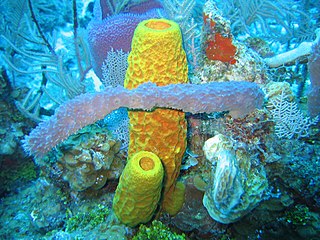
The Clathrinida are an order of calcareous sponges found in marine environments. These sponges have an asconoid structure and lack a true dermal membrane or cortex. The spongocoel is lined with choanocytes.

Halichondrida is an order of marine demosponges. Demosponges with simple spicules and a generally confused skeletal arrangement are grouped into this order although its monophyly is considered suspect and further taxonomic revision can be expected.

Halichondriidae is a family of marine demosponges belonging to the order Suberitida. These sponges have a skeleton consisting of dense bundles of spicules occurring in a more or less random pattern.

Agelas clathrodes, also known as the orange elephant ear sponge, is a species of sea sponge. It lives on reefs in the Caribbean, usually more than 10 metres (33 ft) below the surface of the ocean. It takes various forms, and its color is reddish orange.

Spongia is a genus of marine sponges in the family Spongiidae, originally described by Linnaeus in 1759, containing more than 50 species. Some species, including Spongia officinalis, are used as cleaning tools, but have mostly been replaced in that use by synthetic or plant material.

Homoscleromorpha is a class of marine sponges composed of two families: Plakinidae and Oscarellidae.

Xestospongia testudinaria is a species of barrel sponge in the family Petrosiidae.
Clathrina izuensis is a sponge species in the genus Clathrina. The species is named after the Izu peninsula where the holotype was collected.
Clathrina multiformis is a species of calcareous sponge from Russia.
Ircinia strobilina is a species of sponge in the family Irciniidae. It is grey or shiny black in colour, with spiny structures (conules) dotting the surface. The spiny structures are interconnected by ridges, though not arranged in an orderly lattice. This species is globular and massive in shape, but usually no more than 0.3 metres (1 ft) across. I. strobilina is lobed and spherical and has a tough consistency. The large excurrent pores are located in depressions at the top of the sponge. Many smaller incurrent pores are scattered across the surface, more densely at the sides.
The genus name Aaata has been described as a synonym to two species in the Microcionidae family of sea sponges (Demospongiae). The two species being:

Agelas is a genus of sea sponge in the class Demospongiae.
Agelas schmidti, commonly known as the brown tubular sponge, is a species of demosponge. It occurs at moderate depths in the Gulf of Mexico and the Caribbean Sea and often has a colonial coral growing over the surface. The type locality is Puerto Rico.
Agelas flabelliformis, also known as the elephant ear sponge, is a species of demosponge. It takes the form of a large leathery slender flap and is found in the Caribbean area at depths down to 100 metres (330 ft).

Dictyoceratida is an order of sponges in the subclass Ceractinomorpha containing five families. Along with the Dendroceratida, it is one of the two orders of demosponges that make up the keratose or "horny" sponges, in which a mineral skeleton is minimal or absent and a skeleton of organic fibers containing spongin, a collagen-like material, is present instead.

Ernstia is a genus of calcareous sponges in the family Clathrinidae. The genus was erected in 2013 to contain five species previously assigned to Clathrina. The genus name honors German naturalist Ernst Haeckel for his contributions towards sponge taxonomy and phylogeny.
Guancha apicalis was thought to be a species of calcareous sponge in the genus Guancha from Antarctica. It actually never existed.

Oscarellidae is a family of marine sponges.
Agelas tubulata is a species of demosponge. It is tube-shaped or vase-shaped and variable in colour. It is found in the Caribbean area and along the coasts of Brazil at depths of between about 70 and 90 m. It was first described by Lehnert & van Soest in 1996, the type location being the Greater Antilles.
Agelas dispar is a species of demosponge in the family Agelasidae. It lives on shallow-water reefs in the Caribbean Sea and around the West Indies.









